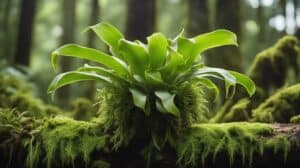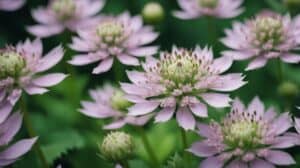The Pink Quill Plant, also known as Tillandsia cyanea, is a popular houseplant that is native to Ecuador.
It is a type of bromeliad that is known for its striking pink flowers that grow from a rosette of leaves.
The plant is relatively easy to care for, making it a great choice for beginners who are looking for a low-maintenance plant to add to their collection.

One of the most unique features of the Pink Quill Plant is its flowers.
The pink bracts that surround the flowers give the plant its name and make it a popular choice for those who are looking for a splash of color in their home.
The flowers themselves are small and white, but they are surrounded by the bright pink bracts that make them stand out.
Despite its exotic appearance, the Pink Quill Plant is relatively easy to care for.
It prefers bright, indirect light and can be grown in a variety of different containers, including hanging baskets, terrariums, and even mounted on a piece of driftwood.
With a little bit of attention and care, the Pink Quill Plant can thrive and add a touch of tropical beauty to any home.
Understanding Tillandsia Cyanea
Species Overview
Tillandsia cyanea, commonly known as Pink Quill Plant, is a type of bromeliad that belongs to the Tillandsia genus.
It is native to the rainforests of Ecuador, where it grows as an epiphyte, meaning it attaches itself to other plants for support.
The plant has a unique appearance, with long, narrow leaves that curl at the ends and a bright pink inflorescence that resembles a feather duster.
The inflorescence is made up of small, tubular flowers that bloom in succession, creating a stunning display that lasts for several weeks.
Origin and Habitat
As mentioned earlier, Tillandsia cyanea is native to the rainforests of Ecuador, where it grows at elevations of up to 1,500 meters above sea level.
In its natural habitat, the plant attaches itself to tree branches and absorbs moisture and nutrients from the air.
The climate in its native range is humid and warm, with temperatures ranging from 18 to 27°C.
The plant is adapted to these conditions and will not survive in temperatures below 10°C.
In cultivation, Tillandsia cyanea is grown as a houseplant and is relatively easy to care for.
It is popular among beginners because of its unique appearance and low maintenance requirements.
With proper care, the plant can live for several years and produce multiple blooms.
Caring for Your Pink Quill Plant

If you want your Pink Quill Plant to thrive, you need to provide it with the proper care.
Here are some tips to help you keep your Tillandsia cyanea healthy and happy.
Light Requirements
The Pink Quill Plant requires bright, indirect light to grow well. Place it near a window that receives bright, filtered light.
Direct sunlight can damage the leaves, so it’s best to avoid placing it in direct sunlight.
Watering Practices
The Pink Quill Plant is a type of air plant that doesn’t require soil to grow. Instead, it absorbs water and nutrients through its leaves.
To water your plant, mist it with water once or twice a week. Alternatively, you can soak it in water for 30 minutes once a week.
Make sure to shake off any excess water after watering to prevent rot.
Temperature and Humidity
The Pink Quill Plant prefers warm temperatures between 60°F and 80°F. It also requires high humidity levels to thrive.
If the air in your home is dry, you can increase the humidity by using a humidifier or placing a tray of water near the plant.
Fertilizing Needs
The Pink Quill Plant doesn’t require fertilizer, but you can give it a boost by fertilizing it once a month during the growing season.
Use a water-soluble fertilizer and dilute it to half strength.
Apply the fertilizer by misting the plant or soaking it in the fertilizer solution for 10-15 minutes.
By following these simple care tips, you can enjoy a beautiful and healthy Pink Quill Plant in your home.
Common Challenges

Pest Infestations
The Pink Quill Plant is prone to pest infestations, which can damage the plant and even kill it if left untreated.
Some of the common pests that attack this plant include mealybugs, spider mites, and scale insects.
To prevent pest infestations, it is important to keep the plant clean and free of debris.
Regularly inspect the plant for any signs of pests, such as webbing, sticky residue, or visible insects.
If pests are detected, they can be treated with insecticidal soap or neem oil.
Diseases and Disorders
The Pink Quill Plant is also susceptible to various diseases and disorders that can affect its growth and appearance.
One of the most common diseases is root rot, which is caused by overwatering or poor drainage.
To prevent root rot, it is important to water the plant sparingly and ensure that the soil is well-draining.
Other common disorders include leaf tip burn, which is caused by too much direct sunlight or low humidity, and leaf curling, which can be caused by overwatering or underwatering.
Overall, with proper care and attention, the Pink Quill Plant can thrive and add a pop of color to any indoor space.
Propagation and Repotting

Propagation Methods
Pink Quill Plants are easy to propagate. The most common method is by division.
To do this, gently remove the offsets from the mother plant and plant them in a new pot.
Make sure to keep the new plant in a warm and humid environment until it establishes roots.
Another method is by seed. However, it can take up to two years for the seeds to germinate, so it requires patience.
To propagate by seed, collect the seeds from the plant and plant them in a well-draining potting mix.
Keep the soil moist and warm until the seeds germinate.
When to Repot
Pink Quill Plants do not need to be repotted often. They prefer to be root-bound, so it is best to wait until the plant outgrows its pot before repotting.
When repotting, use a well-draining potting mix and a pot that is only slightly larger than the current one.
It is best to repot in the spring or summer when the plant is actively growing.
Before repotting, gently remove the plant from its current pot and loosen any tangled roots. Then, place the plant in the new pot and fill it with fresh soil.
Water the plant thoroughly and let it drain before placing it in a bright, indirect light location.
Frequently Asked Questions

How can I prevent my Pink Quill from turning brown?
Pink Quill plants can turn brown if they are exposed to direct sunlight or if they are not receiving enough water.
To prevent your Pink Quill from turning brown, make sure that it is placed in a bright, indirect light and that you are watering it regularly.
You can also mist your plant with water once or twice a week to keep it hydrated.
What are the steps for propagating Pink Quill plants?
To propagate Pink Quill plants, you can remove the offsets that grow from the base of the plant.
Wait until the offset is at least one-third the size of the parent plant before removing it.
Gently pull the offset away from the parent plant and plant it in a new pot with fresh soil.
Water the new plant regularly and keep it in a bright, indirect light.
What should I do with a Pink Quill after it finishes flowering?
After a Pink Quill finishes flowering, you can cut off the spent flower spike with a pair of clean scissors.
The plant will continue to grow and produce new leaves, but it may take some time before it flowers again.
How often should I water my Pink Quill to maintain its health?
Pink Quill plants should be watered once a week by soaking them in water for about 30 minutes.
Make sure that the plant is completely dry before placing it back in its pot or container.
You can also mist your plant with water once or twice a week to keep it hydrated.
Why isn’t my Pink Quill blooming, and how can I encourage it?
Pink Quill plants need bright, indirect light and regular watering to bloom.
If your plant is not blooming, make sure that it is receiving enough light and water.
You can also fertilize your plant with a balanced, water-soluble fertilizer once a month during the growing season to encourage blooming.
What are the benefits of having a Pink Quill in my home?
Pink Quill plants are not only beautiful but also have air-purifying properties.
They can help to remove toxins from the air and improve the overall air quality in your home.
Additionally, they are easy to care for and can add a touch of color and texture to any room.














